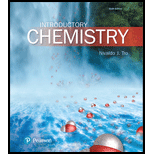
Interpretation: Name of each of the given compound is to be determined by including a detailed step-by-step description of the process.
Concept Introduction: Binary metal compound consists of only two different elements.
While naming the binary ionic compounds consist of a metal that forms one type of ion, the metal cation is written first followed by the name of the anion.
The compound consists of a metal that forms more than one class of cation, in such compounds, charge is specified in the parentheses.
In order to name the ionic compounds that contain the polyatomic ion as an anion, write the name of the cation followed by the name of the polyatomic ion.
The name of molecular compound begins with the name of the first element and appropriate prefix is used with that, followed by the name of the anion.
Want to see the full answer?
Check out a sample textbook solution
Chapter 5 Solutions
Introductory Chemistry (6th Edition)
- certain transition metal ion (Mn+) forms a compound with oxygen (MxOy) . The molar mass of the compound is 250.2 g/mol. If the charge on the transition metal ion is +3, what is the identity of the transition metal, M? l type='a'> Th Ti Hg Ru Agarrow_forwardChalky, white crystals in mineral collections are often labeled borax, which has the molecular formula Na2B4O7 10H2O, when actually they are partially dehydrated samples with the molecular formula Na2B4O7 5H2O, which is more stable under the storage conditions. Real crystals of borax are colorless and transparent. (a) Calculate the percent mass that the mineral has lost when it partially dehydrates. (b) Is the percent boron by mass the same in both compounds?arrow_forwardWhat number of atoms of nitrogen are present in 1.00 g of each of the compounds in Exercise 51?arrow_forward
- 4.104 When 2.750 g of the oxide Pb3O4 is heated to a high temperature, it decomposes to produce 0.0640 g of oxygen gas and 2.686 g of some new lead oxide compound. How can you use these data to determine the formula of the new compound?arrow_forwardWhich of these elements is most reactive? -- I F Br Clarrow_forwardA metal sulfide M 2 S contains 14.3% of sulfur by massWhat is the identity of the metal in this sulfide?arrow_forward
 Chemistry: The Molecular ScienceChemistryISBN:9781285199047Author:John W. Moore, Conrad L. StanitskiPublisher:Cengage Learning
Chemistry: The Molecular ScienceChemistryISBN:9781285199047Author:John W. Moore, Conrad L. StanitskiPublisher:Cengage Learning Chemistry for Engineering StudentsChemistryISBN:9781337398909Author:Lawrence S. Brown, Tom HolmePublisher:Cengage Learning
Chemistry for Engineering StudentsChemistryISBN:9781337398909Author:Lawrence S. Brown, Tom HolmePublisher:Cengage Learning Chemistry & Chemical ReactivityChemistryISBN:9781337399074Author:John C. Kotz, Paul M. Treichel, John Townsend, David TreichelPublisher:Cengage Learning
Chemistry & Chemical ReactivityChemistryISBN:9781337399074Author:John C. Kotz, Paul M. Treichel, John Townsend, David TreichelPublisher:Cengage Learning
 ChemistryChemistryISBN:9781305957404Author:Steven S. Zumdahl, Susan A. Zumdahl, Donald J. DeCostePublisher:Cengage Learning
ChemistryChemistryISBN:9781305957404Author:Steven S. Zumdahl, Susan A. Zumdahl, Donald J. DeCostePublisher:Cengage Learning Chemistry: An Atoms First ApproachChemistryISBN:9781305079243Author:Steven S. Zumdahl, Susan A. ZumdahlPublisher:Cengage Learning
Chemistry: An Atoms First ApproachChemistryISBN:9781305079243Author:Steven S. Zumdahl, Susan A. ZumdahlPublisher:Cengage Learning





